文章目录
- 一、基本概念
- 1.时代背景
- 2. 基本概念
- 3.基本性质
- 二、实现原理
- 1. 插入
- 1.1变色
- 1.2旋转+变色
- ①左旋
- ②右旋
- ③右左双旋
- ④左右双旋
- 2.验证
- 源码
- 总结
一、基本概念
1.时代背景
- 1972年鲁道夫·拜尔(Rudolf Bayer)发明了一种数据结构,这是一种特殊的B树4阶情况。这些树保持了从根到叶的所有路径,节点数量相同,创造了完美平衡的树。但是,它们不是二叉搜索树。拜耳在他的论文中称它们为“对称二元B树”。这是红黑树的起源。

- 在1978年的一篇论文“平衡树的二色框架”中,列奥尼达斯·吉巴斯(Leonidas J. Guibas )和罗伯特·塞奇威克(Robert Sedgewick)从对称的二元B树中推导出了红黑树。选择“红色”是因为它是作者在施乐PARC工作时可用的彩色激光打印机产生的最好看的颜色。吉巴斯的另一个回应说,这是因为他们可以使用红色和黑色的笔来画树。


第一张为——列奥尼达斯·吉巴斯,第二张为——罗伯特·塞奇威克。
- 1993年,Arne Andersson引入了右倾树的想法,以简化插入和删除操作。

- 1999年,Chris Okasaki展示了如何使插入操作纯粹功能化。它的平衡功能只需要处理 4 个不平衡情况和一个默认平衡情况。

详细请看:维基百科
2. 基本概念
红黑树,是一种二叉搜索树,但在每个结点上增加一个存储位表示结点的颜色,可以是Red或
Black。 通过对任何一条从根到叶子的路径上各个结点着色方式的限制,红黑树确保没有一条路 径会比其他路径长出俩倍,因而是接近平衡的。
- 实现平衡的关键:
最长路径小于等于最短路径的两倍。
3.基本性质
- 每个结点不是红色就是黑色
根节点是黑色的如果一个节点是红色的,则它的两个孩子结点是黑色的(如果一个结点是黑色的,则其两个孩子可以是红的也可以是黑的。)对于每个结点,从该结点到其所有后代叶结点的简单路径上,均包含相同数目的黑色结点- 每个叶子结点都是黑色的(此处的叶子结点指的是空结点)
强调:2,3,4点是有关联的,且是最关键的3点。
- 假设根节点如果是红的,那么插入的结点就是只能是黑的(3),那么就违背了(4)。
- 对于3分析,孩子结点为空,但空节点也被理解成黑色(5),因此(5)是用来辅助(3)的。
- 对于4分析,可推理出两个结论——
1 . 插入结点必须为红色的。
2 . 满足最长路径小于最短路径的两倍(概念)。对此点可以看做间隔问题,即n个数之间(不算头一个数),有n个间隔,即n个黑结点(不算根节点),之间最多有n个红结点。
二、实现原理
1. 插入
1.1变色
根本逻辑:基于每条路径的黑色结点不变。
第一种变色方式:
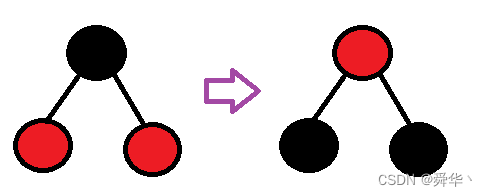
这样变,是不是每条路径的黑色结点数没变呢?
那这样变的前提是什么呢?
- 黑色结点的左右孩子为红且不为空。
那什么时候发生变色呢?
- 基于性质3,红色结点的两个孩子必须为黑,但由4我们可以推出每次插入结点必须为红,那这时候我们按照4的原则进行处理,使处理结果符合3即可,怎么处理,就是进行变色。
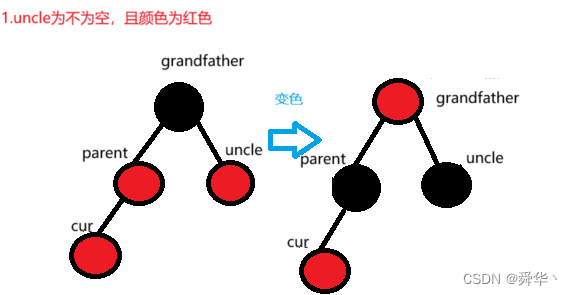
此时,parent的右边进行插入新节点,且parent在grandfather的左边。
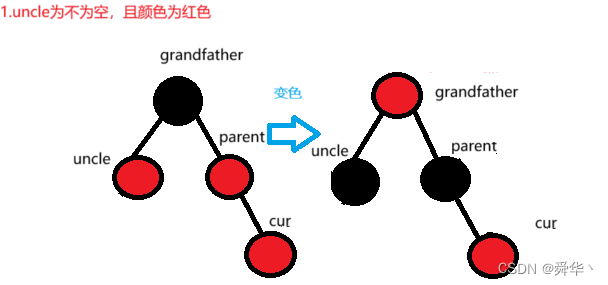
此时在parent的右边进行插入,且parent为grandfather的左节点。
- 总结
- 变色的前提是每条路径的黑色结点不变
- uncle非空且为红,且parent为红,变grandfather为红,parent与uncle为黑。
继续分析,如果grandfather为红,其父节点是否可能为红呢?
- 答案是可能的。
因此我们需要继续往上更新:
- 更新cur为grandfather
- parent为cur的parent
接着分析,如果grandfather为根节点呢?
- 由于性质2,我们需要再次修改根节点的颜色为黑。
1.2旋转+变色
前面我们分析了一种简单的只需变色的情况,我们下面接着分析另外一种情况。
第二种变色需要在旋转的基础上进行分类讨论,具体情况有四种。
①左旋

补充:当uncle为黑结点时,parent的左子树不为空且根节点为黑色,cur的左右子树同理,这里不过多分析了,因为具体情况过多分析容易提高理解难度。
- 开始时parent在grandfather右边,且cur在parent的右边
②右旋

对uncle的补充同左旋
- 开始时parent在grandfather左边,且cur在parent的左边
③右左双旋

对uncle的补充同左旋
- 开始时parent在grandfather的右边,且cur在parent的左边
④左右双旋

对uncle的补充同左旋
-
开始时parent在grandfather的左边,且cur在parent的右边
-
总结
根据parent的位置我们可以大致分为两种情况:
-
parent在grandfather的左边
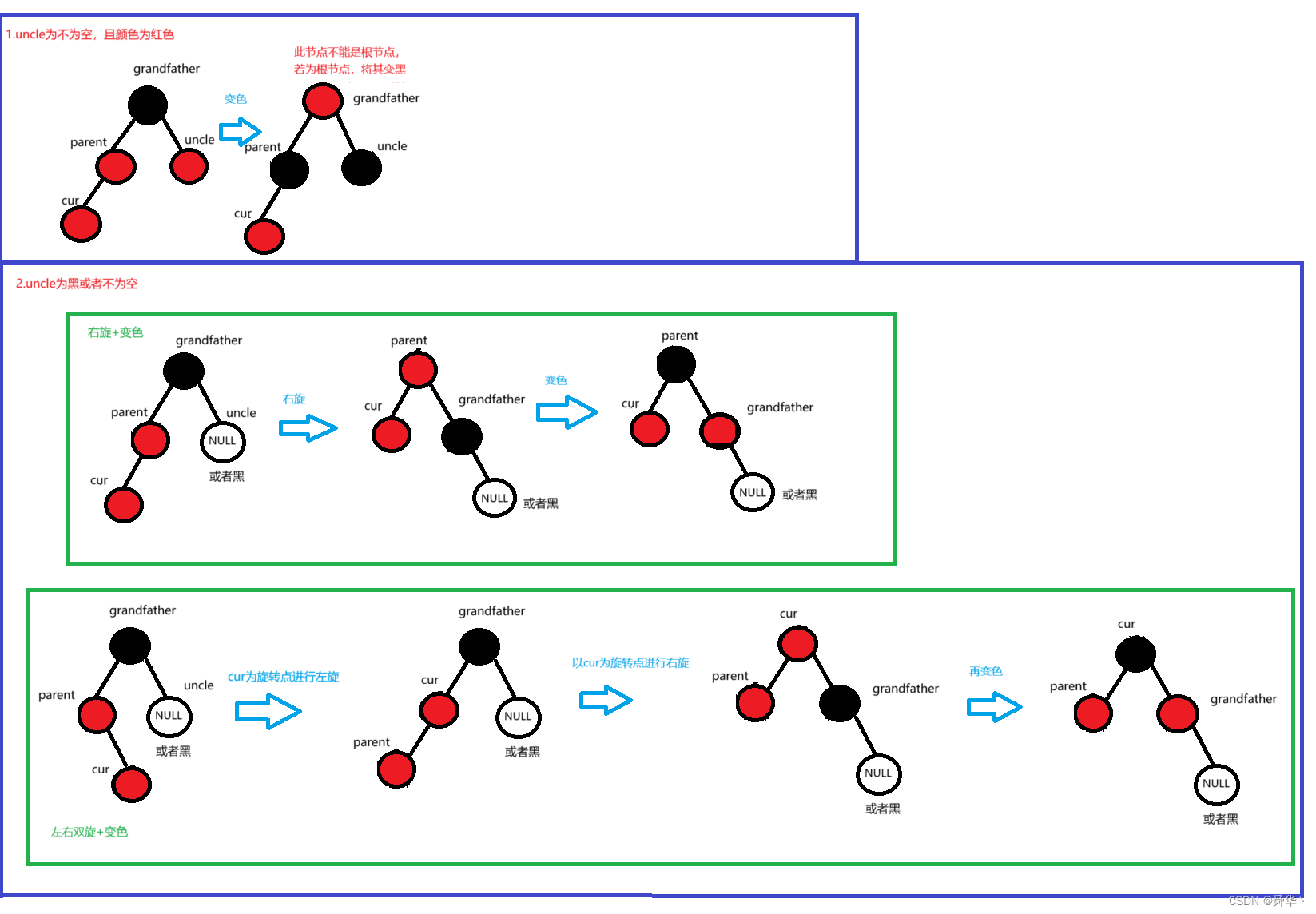
-
parent在grand的右边
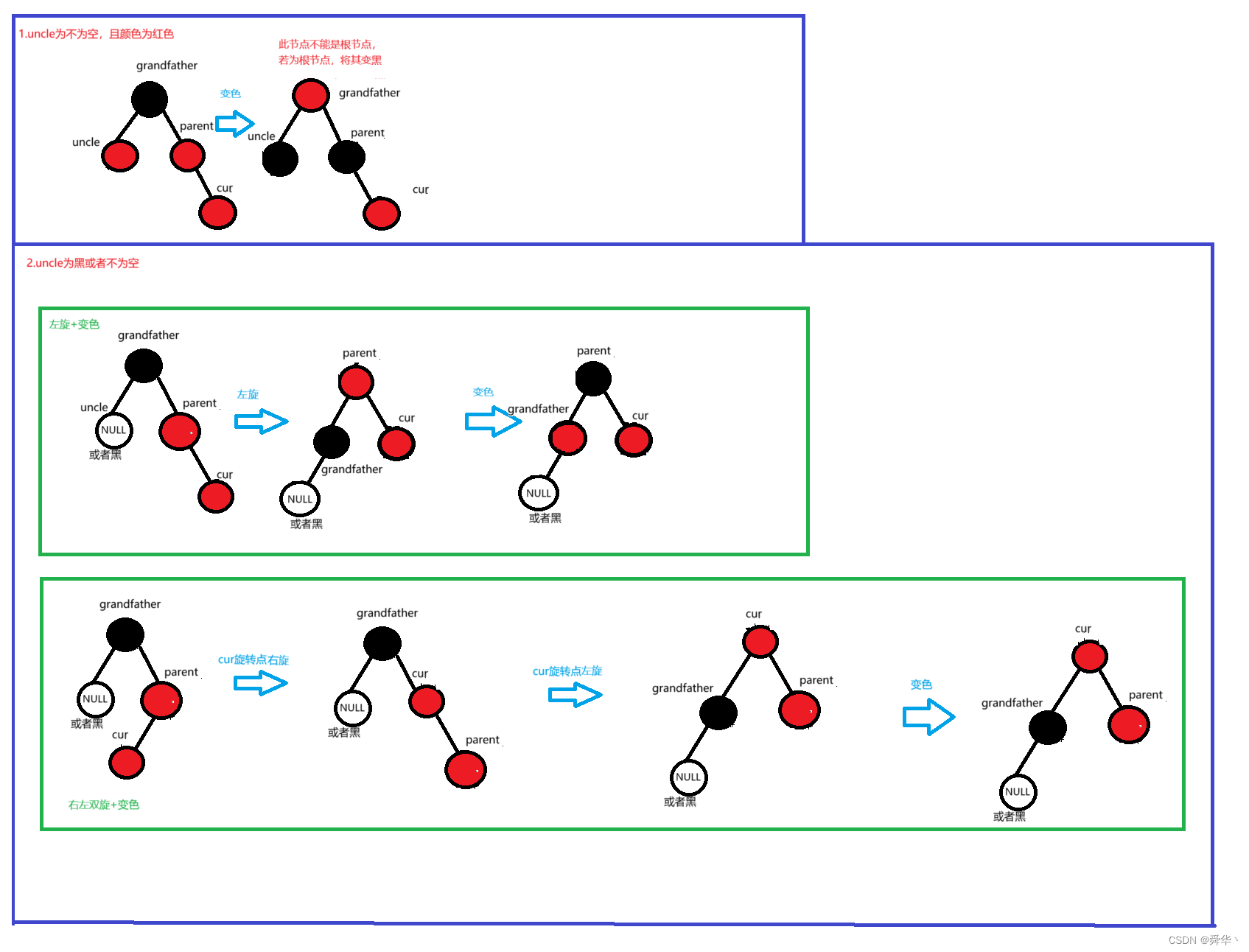
其实不难看出,AVL和红黑树都会进行旋转,只是AVL树旋转后处理的是平衡因子,红黑树旋转后处理的是变色,归根结底终究都是为了让树达到平衡。
- 核心代码
//判断是否要进行旋转变色
//当父节点为红色说明要进行判断
while (parent && parent->_col == RED)
{//爷爷结点Node* grandfather = parent->_parent;if (grandfather->_left == parent){Node* uncle = grandfather->_right;if (uncle && uncle->_col == RED)//如果uncle存在且为红色{//变色parent->_col = uncle->_col = BLACK;grandfather->_col = RED;//继续往上迭代进行分析cur = grandfather;parent = cur->_parent;}else//如果uncle不存在或者为黑色{//旋转if (parent->_left == cur){RotateR(grandfather);parent->_col = BLACK;cur->_col = grandfather->_col = RED;}else{RotateL(parent);RotateR(grandfather);cur->_col = BLACK;parent->_col = grandfather->_col = RED;}break;}}else//grandfather->_right == parent{Node* uncle = grandfather->_left;if (uncle && uncle->_col == RED){//变色grandfather->_col = RED;parent->_col = uncle->_col = BLACK;//往上更新cur = grandfather;parent = cur->_parent;}else{if (parent->_right == cur){//旋转RotateL(grandfather);//变色parent->_col = BLACK;grandfather->_col = cur->_col = RED;}else{RotateR(parent);RotateL(grandfather);cur->_col = BLACK;grandfather->_col = parent->_col = RED;}break;}}
}
- 插入代码
bool insert(const pair<Key, Val>& val)
{//第一步:插入操作//如果根节点为空if (_root == nullptr){_root = new Node(val);_root->_col = BLACK;return true;}else{Node* cur = _root, * parent = _root;while (cur){if (cur->_key > val.first){parent = cur;cur = cur->_left;}else if (cur->_key < val.first){parent = cur;cur = cur->_right;}else{return false;}}cur = new Node(val);if (parent->_key > val.first){parent->_left = cur;}else{parent->_right = cur;}//更新新增结点的_parentcur->_parent = parent;//判断是否要进行旋转变色//当父节点为红色说明要进行判断while (parent && parent->_col == RED){//爷爷结点Node* grandfather = parent->_parent;if (grandfather->_left == parent){Node* uncle = grandfather->_right;if (uncle && uncle->_col == RED)//如果uncle存在且为红色{//变色parent->_col = uncle->_col = BLACK;grandfather->_col = RED;//继续往上迭代进行分析cur = grandfather;parent = cur->_parent;}else//如果uncle不存在或者为黑色{//旋转if (parent->_left == cur){RotateR(grandfather);parent->_col = BLACK;cur->_col = grandfather->_col = RED;}else{RotateL(parent);RotateR(grandfather);cur->_col = BLACK;parent->_col = grandfather->_col = RED;}break;}}else//grandfather->_right == parent{Node* uncle = grandfather->_left;if (uncle && uncle->_col == RED){//变色grandfather->_col = RED;parent->_col = uncle->_col = BLACK;//往上更新cur = grandfather;parent = cur->_parent;}else{if (parent->_right == cur){//旋转RotateL(grandfather);//变色parent->_col = BLACK;grandfather->_col = cur->_col = RED;}else{RotateR(parent);RotateL(grandfather);cur->_col = BLACK;grandfather->_col = parent->_col = RED;}break;}}}//根节点可能为红色,不管红色还是黑色都弄成黑色_root->_col = BLACK;return true;}
}
2.验证
- 原理
- 根节点不能为红
- 每条路径的黑色结点数相同
- 每条路径不能出现连续的红色结点。
- 代码
bool _IsRBTree(Node* root)
{if (root == nullptr)return true;//根节点是黑色的if (root->_col == RED)return false;//各个路径的黑色结点数是相同的,因此设立一个基准进行比较合适,//再对树进行遍历求每个路径的黑色结点的数量,最后比较即可。int benchmark = 0;Node* cur = root;while (cur){if (cur->_col == BLACK)benchmark++;cur = cur->_left;}return Check(root);
}
bool Check(Node* root, int BCount,int benchmark)
{if (root == nullptr){//验证基准值是否等于黑色结点数//只要有一个不是,即不是红黑树。if (BCount != benchmark)return false;return true;}//求每条黑色结点的个数if (root->_col == BLACK)BCount++;//验证性质3,即不能有连续的红色结点。if (root->_col == RED && root->_parent && root->_parent->_col == RED){return false;}return Check(root->_left,BCount,benchmark) && Check(root->_right, BCount, benchmark);
}
源码
#pragma once
#include<iostream>
using namespace std;
namespace MY_STL
{enum Color{RED = 0,BLACK = 1};template<class Key,class Val>struct RBTreeNode{typedef RBTreeNode<Key, Val> Node;RBTreeNode(const pair<Key,Val>& key):_key(key.first),_val(key.second),_right(nullptr),_left(nullptr),_parent(nullptr),_col(RED){}Node* _right;Node* _left;Node* _parent;Key _key;Val _val;Color _col;};template<class Key,class Val>class RBTree{typedef RBTreeNode<Key, Val> Node;public:bool insert(const pair<Key, Val>& val){//第一步:插入操作//如果根节点为空if (_root == nullptr){_root = new Node(val);_root->_col = BLACK;return true;}else{Node* cur = _root, * parent = _root;while (cur){if (cur->_key > val.first){parent = cur;cur = cur->_left;}else if (cur->_key < val.first){parent = cur;cur = cur->_right;}else{return false;}}cur = new Node(val);if (parent->_key > val.first){parent->_left = cur;}else{parent->_right = cur;}//更新新增结点的_parentcur->_parent = parent;//判断是否要进行旋转变色//当父节点为红色说明要进行判断while (parent && parent->_col == RED){//爷爷结点Node* grandfather = parent->_parent;if (grandfather->_left == parent){Node* uncle = grandfather->_right;if (uncle && uncle->_col == RED)//如果uncle存在且为红色{//变色parent->_col = uncle->_col = BLACK;grandfather->_col = RED;//继续往上迭代进行分析cur = grandfather;parent = cur->_parent;}else//如果uncle不存在或者为黑色{//旋转if (parent->_left == cur){RotateR(grandfather);RotateCount++;parent->_col = BLACK;cur->_col = grandfather->_col = RED;}else{RotateL(parent);RotateR(grandfather);RotateCount+=2;cur->_col = BLACK;parent->_col = grandfather->_col= RED;}break;}}else//grandfather->_right == parent{Node* uncle = grandfather->_left;if (uncle && uncle->_col == RED){//变色grandfather->_col = RED;parent->_col = uncle->_col = BLACK;//往上更新cur = grandfather;parent = cur->_parent;}else{if (parent->_right == cur){//旋转RotateL(grandfather);RotateCount++;//变色parent->_col = BLACK;grandfather->_col = cur->_col = RED;}else{RotateR(parent);RotateL(grandfather);RotateCount += 2;cur->_col = BLACK;grandfather->_col = parent->_col = RED;}break;}}}//根节点可能为红色,不管红色还是黑色都弄成黑色_root->_col = BLACK;return true;}}bool IsRBTree(){return _IsRBTree(_root);}size_t Height(){return Height(_root);}private:size_t Height(Node* root){if (root == nullptr){return 0;}int LHeight = Height(root->_left);int RHeight = Height(root->_right);return max(LHeight, RHeight) + 1;}bool _IsRBTree(Node* root){if (root == nullptr)return true;//根节点是黑色的if (root->_col == RED)return false;//各个路径的黑色结点数是相同的,因此设立一个基准进行比较int benchmark = 0;Node* cur = root;while (cur){if (cur->_col == BLACK)benchmark++;cur = cur->_left;}return Check(root,0,benchmark);}bool Check(Node* root, int BCount,int benchmark){if (root == nullptr){//验证基准值是否等于黑色结点数//只要有一个不是,即不是红黑树。if (BCount != benchmark)return false;return true;}//求每条黑色结点的个数if (root->_col == BLACK)BCount++;//验证性质3,即不能有连续的红色结点。if (root->_col == RED && root->_parent && root->_parent->_col == RED){return false;}return Check(root->_left,BCount,benchmark) && Check(root->_right, BCount, benchmark);}void RotateL(Node* parent){//画图分析://操作的结点有cur,cur_left,ppnodeNode* cur = parent->_right;Node* cur_left = cur->_left;//将parent的右节点改为cur_leftparent->_right = cur_left;//改变cur_left父节点的转向//cur_left可能为空if (cur_left != nullptr){cur_left->_parent = parent;}//将parent链接在cur的左边//为了更新cur的parent需要保存parent的父节点Node* ppnode = parent->_parent;cur->_left = parent;parent->_parent = cur;//ppnode可能为空if (ppnode == nullptr){//需要修改根节点_root = cur;cur->_parent = nullptr;}else{//改变ppnode的指向if (ppnode->_left == parent){ppnode->_left = cur;}else{ppnode->_right = cur;}cur->_parent = ppnode;}}void RotateR(Node* parent){//操作的结点Node* cur = parent->_left;Node* cur_right = cur->_right;//第一步:将cur_right链接到parent的leftparent->_left = cur_right;//更改cur_right的父节点//注意:cur_right可能为空if (cur_right != nullptr){cur_right->_parent = parent;}//第二步:将parent链接到cur的右结点。//先保存一下parent的父节点Node* ppnode = parent->_parent;cur->_right = parent;parent->_parent = cur;//ppnode为空说明需要修改根节点if (ppnode == nullptr){_root = cur;cur->_parent = nullptr;}else{if (ppnode->_left == parent){ppnode->_left = cur;}else{ppnode->_right = cur;}cur->_parent = ppnode;}}Node* _root = nullptr;public:size_t RotateCount = 0;};
};
总结
红黑树的理解较AVL树抽象,需要画图分析,不过有了AVL树旋转的基础,这里的难度要下降不少。还是与之前一样,只要图画的好,代码跑不了,所以这里的关键就在于画图。
总之,今天的分享到这里就结束了,如果感觉有所帮助,不妨点个赞鼓励一下吧!
 -框架设置操作)




)
)




)





)

)